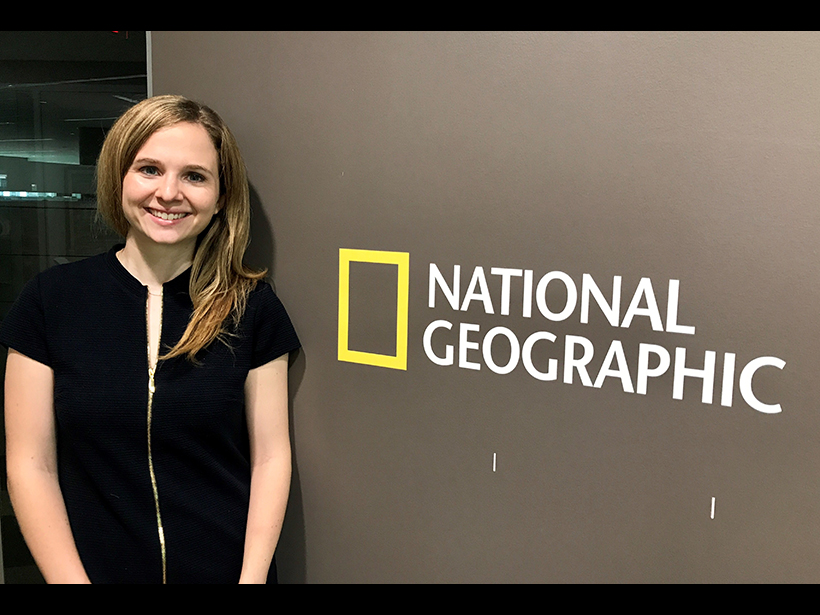The night before my mass media fellowship at National Geographic started, I was pacing around my room and wringing my hands. I woke up almost every hour that night—how could I sleep knowing I would be starting the following morning at the first science publication I ever read?
Walking into the National Geographic headquarters that morning was one of the most nerve-racking and exciting experiences of my life. As a scientist, I knew how things went in the lab and what was expected of me in that setting. What I didn’t know was how it would all translate to working at one of the most storied companies in science media.
Dream Team
I was able to interview scientists and adventurers from all over the world.
Fortunately for me, the incredible team I was able to work with meant those nerves quickly dissipated. I rapidly went from anxious to pitching and writing exciting stories about baby elephant rescues, skull cults, underwater “spiders,” and manta rays. I was able to interview scientists and adventurers from all over the world. Some of my stories came together in hours, others in days or weeks, but all of them taught me something new about how to write about science for a fascinated public.
Often, my work involved writing about viral animal videos and the latest weird picture going around the Internet. I appreciated these assignments because, by interviewing expert scientists, I could provide readers with bona fide insights regarding these puzzling phenomena (usually animal behavior) and provide context for this off-beat news.
I felt like I contributed in a valuable way to the National Geographic team and was happy to find a home in journalism as a scientist who loved science communication. My work was truly appreciated at National Geographic—something I never thought would happen to me as a lowly fellow.
I didn’t have to stop at scientific topics, either. I was able to get a broader experience writing for National Geographic because of opportunities to write articles accompanying photography stories from around the world. I wrote about circumcision rituals in Uzbekistan, California wildfires, and men who claim to be the Messiah. Reporting outside of the science beat helped me greatly to further hone my craft and develop my writing skills. Every day was truly something completely new and exciting.
Why Communicate Science?
Any scientist who is interested in communicating their science with the public should at least put a toe into journalism—it will transform you and the way you understand the world.
Writing for National Geographic for 10 weeks this past summer became a reality for me thanks to the Mass Media Science and Engineering Fellowships of the American Association for the Advancement of Science (AAAS) and to the American Geophysical Union’s annual support of an AAAS fellow.
My experience at National Geographic was one of the most formative and important of my entire career so far. Any scientist who is interested in communicating their science with the public should at least put a toe into journalism—it will transform you and the way you understand the world. Even though some of us love to read and write 200-plus-page dissertations about narrow scientific research that only a handful of people will read, reporting on science as a journalist gives us the opportunity to share the big picture of important fields and findings with the general public, which is vital in this day and age.
For science to impact society, it has to mean something to people. It can inspire, it can heal, and it can transform the way one looks at the world. Quality science reporting for popular publications like National Geographic has the capability of expanding readers’ worldviews by showing them a corner of the planet they never knew existed or teaching them why the extinction of one tiny species matters. Some of the best people to describe this in a passionate way are scientists.
Learn by Doing
I had done some science writing before the fellowship, but being able to dedicate myself, full time, to the craft of news writing while at National Geographic has changed everything about how I relate my science to the world. The experience in the newsroom was invaluable. I will continue writing as much as I can and applying what I’ve learned about science communication to my current position as an AAAS Science and Technology Policy Fellow.
Do yourself a favor and apply for your own Mass Media Fellowship by 15 January 2018—you’ll be glad you did!
—Shaena Montanari (email: [email protected]; @DrShaena), 2017 AGU Mass Media Fellow
Citation:
Montanari, S. (2017), A superb summer of science journalism, Eos, 98, https://doi.org/10.1029/2017EO087299. Published on 28 November 2017.
Text © 2017. The authors. CC BY-NC-ND 3.0
Except where otherwise noted, images are subject to copyright. Any reuse without express permission from the copyright owner is prohibited.

